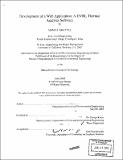Development of a Web application : a HVRL thermal analysis software
Author(s)
Bhattal, Nimrat, 1977-
DownloadFull printable version (6.429Mb)
Alternative title
High Voltage Research Laboratory thermal analysis software
Other Contributors
Massachusetts Institute of Technology. Dept. of Civil and Environmental Engineering.
Advisor
George Kocur.
Terms of use
Metadata
Show full item recordAbstract
In this thesis, I describe the development of the Thermal Analysis Software for the High Voltage Research Laboratory at MIT. The goal of the Thermal Analysis Software is to provide a means to monitor and analyze valuable infrastructure like transformers.The civil and electrical engineering tasks, which have been done by very traditional ways, can experience a revolution when those jobs are combined with information technology. For example, maintaining infrastructures has been one of the main tasks in engineering. Maintenance and rehabilitation (M&R) should start with measures of performances of the infrastructures. However, the traditional M&R has something to be re-considered. First of all, measuring the performance cannot be real time. The conditions of infrastructures are changing, but all we can know by a traditional measure of performance is the condition at the time that was monitored. We are not able to be sure that the infrastructure is safe now, based on the past data. The second thing is monitoring a dangerous infrastructure traditionally can bring disaster that can harm inspectors fatally because most of jobs are done in-person, inside or around the potentially risky infrastructure. Another thing is financial aspect. The older infrastructure has the more things to be monitored more often. If we depend on only labor of human, the older infrastructure means the higher expense on the M&R. In this point, the advance of information technology can be the solution for those problems. Modern communication technology is using millisecond or even smaller one as unit, so it is real time even though there are some delays on network, especially comparing the measurement done by person. The other advantage of using information technology for monitoring infrastructure is that we do not need to worry about the safety of workers. Once installed monitoring system will send data to the workers who are working in the safe office, so no one needs to enter the dangerous infrastructures. As mentioned before, already installed monitoring system, which uses modern information technology and communication skill, does not need spend fund for labor, and gives data as often as necessary. That means there is only low extra cost for measuring infrastructures. With these reasons, it would be very useful if we were able to come up with a strategy for predicting the level of service or hazards.
Description
Thesis (M.Eng.)--Massachusetts Institute of Technology, Dept. of Civil and Environmental Engineering, 2003. Includes bibliographical references (leaves 45-46).
Date issued
2003Department
Massachusetts Institute of Technology. Department of Civil and Environmental EngineeringPublisher
Massachusetts Institute of Technology
Keywords
Civil and Environmental Engineering.